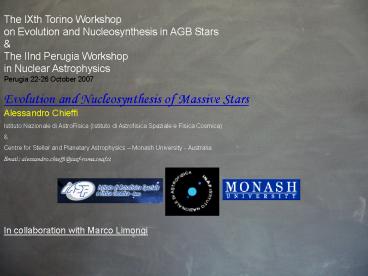Evolution and Nucleosynthesis of Massive Stars - PowerPoint PPT Presentation
1 / 37
Title:
Evolution and Nucleosynthesis of Massive Stars
Description:
Centre for Stellar and Planetary Astrophysics Monash ... The peak temperature of the blast wave does not depend on the stellar structure. CONSEQUENCE: ... – PowerPoint PPT presentation
Number of Views:28
Avg rating:3.0/5.0
Title: Evolution and Nucleosynthesis of Massive Stars
1
The IXth Torino Workshop on Evolution and
Nucleosynthesis in AGB Stars The IInd Perugia
Workshop in Nuclear Astrophysics
Perugia 22-26 October 2007
Evolution and Nucleosynthesis of Massive Stars
Alessandro Chieffi Istituto Nazionale di
AstroFisica (Istituto di Astrofisica Spaziale e
Fisica Cosmica) Centre for Stellar and
Planetary Astrophysics Monash University -
Australia Email alessandro.chieffi_at_iasf-roma.inaf
.it
In collaboration with Marco Limongi
2
What is a Massive star ?
It is a star that goes through all the
hydrostatic burnings from H to Si and explodes as
a core collapse supernova
Mup
MPISN
lt Massive stars lt
gt120
8 - 10
Why are Massive stars important in the global
evolution of our Universe?
Strong responsible for the chemical enrichment of
the gas
Eject an enormous amount of energy as neutrinos
and kinetic energy of the ejecta
Main producers of g ray emitters ( 26Al , 60Fe ,
44Ti , 56Ni)
Parents of a large fraction of neutron stars and
black holes
etc. etc. ......
3
schematically
H-burning
He-burning
C-burning
Hydrostatic evolution
Ne-burning
O-burning
Si-burning
collapse and core bounce formation of a shock
wave that moves outward ??????? the shock wave
successfully exits the Fe core Some fall back
may occur
Core collapse and explosion
4
BSGWR
RSG
RSGWR
Final mass
Type II
Type I bc
WCO
WNL
WNE
BLACK HOLE
NEUTRON STAR
5
(No Transcript)
6
(No Transcript)
7
Basic level
Spherical symmetry
Local treatment of the convective motions
(Schwarzchild and/or Ledoux mixing length
theory or something similar p.o.)
Mass loss
Micro-physics EOS, k, cross sections, n-prod.
Simulate the explosion by imposing the amount of
energy gained by the core bounce
8
Set of massive stars extending between 11 and 120
MO
FRANEC (release 5.050419) Mass Loss
included Vink, J. S., de Koter, A.,
Lamers, H. J. G. L. M. 2000, AA, 362, 295
Vink, J. S., de Koter, A., Lamers, H. J. G. L.
M. 2001, AA, 369, 574 de Jager, C.,
Nieuwenhuijzen, H., van der Hucht, K. A. 1988,
AAS, 72, 259 Nugis, T., Lamers, H. J. G.
L. M. 2000, AA, 360, 227 OR Langer, N.
1989, AA, 220, 135 Mixing treated as a
diffusive process and fully coupled to the local
burning
9
(No Transcript)
10
(No Transcript)
11
(No Transcript)
12
H burning mass loss
(Teff , Vinf / Vesc)
13
The central He burning
All stars form a convective core
The physical evolution of the star requires the
inclusion of just 2 processes a(2a,g)12C and
12C(a,g)16O
The amount of C left by the He burning depends at
least from the interplay among these two
processes and the convective motions
14
The influence of mass loss on the central He
burning
M gt 30 MO
Eject all the H rich mantle a fraction of the
He core mass
30 MO
35 MO
15
Once T raises above 108 K pair neutrino losses
dominate...
16
Once T raises above 108 K pair neutrino losses
dominate...
17
(No Transcript)
18
NL00
LA89
19
- Explosive burnings computed by adopting a kinetic
bomb - An outward velocity v0 is imposed at M1MO and
tuned to obtain the desired result - final kinetic energy of the ejecta
- the ejection of a given amount of 56Ni
- A PPM hydrodynamic code has been developed to
follow the passage of the shock wave through the
mantle.
The mass of the remnant strongly depends on the
chosen final kinetic energy of the ejecta!
20
BASIC PROPERTIES OF THE SHOCK WAVE AFTER IT HAS
ESCAPED THE DENSE FE CORE
RADIATION DOMINATED
ADIABATIC EXPANSION
CONSEQUENCE
The peak temperature of the blast wave does not
depend on the stellar structure
Fe core
T1
T2
r
r1
r2
A simple but quite effective computation of the
explosive yields may be obtained by assuming
21
(No Transcript)
22
(No Transcript)
23
(No Transcript)
24
BSGWR
RSG
RSGWR
Final mass
Type II
Type I bc
WCO
WNL
WNE
BLACK HOLE
NEUTRON STAR
25
M HC0
BSGWR
RSG
RSGWR
He convective core
He core
Type I bc
Type II
Base convective envelope
WCO
WNL
WNE
H convective core
Initial mass
CO core
Final mass
He convective shell
BLACK HOLE
Outer border of the explosive burnings
C convective shell
Fe core mass
NEUTRON STAR
NEUTRON STAR
26
Few global numbers
NL00
LA89
8.7
15
Remnant (Mass fraction)
84
70
Neutron stars (Number fraction)
16
30
Black Holes (Number fraction)
27
Mass Loss in the WNE / WCO phases Langer89
- Nugis Lamers 00
28
Mass Loss in the WNE / WCO phases Langer89
- Nugis Lamers 00
29
(No Transcript)
30
(No Transcript)
31
Whats coming up?
32
4 equations describe the physical structure of
the star at each fixed time
n equations describe the temporal evolution of
the n nuclear species included in the network
33
4 equations describe the physical structure of
the star at each fixed time
n equations describe the temporal evolution of
the n nuclear species included in the network
34
4 equations describe the physical structure of
the star at each fixed time
n equations describe the temporal evolution of
the n nuclear species included in the network
35
4 equations describe the physical structure of
the star at each fixed time
n equations describe the temporal evolution of
the n nuclear species included in the network
36
4 equations describe the physical structure of
the star at each fixed time
n equations describe the temporal evolution of
the n nuclear species included in the network
Full Raphson-Newton
FRANEC (rel. 6.071009)
(N4) equations x ( of meshes) (105 eqs solved
simultaneously)
37
Much more to come next year!
stay tuned































